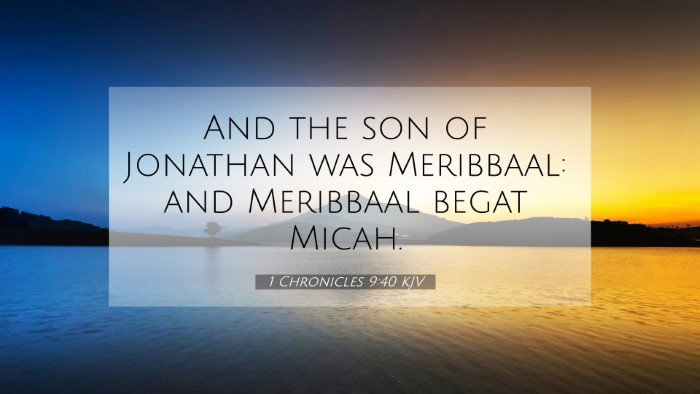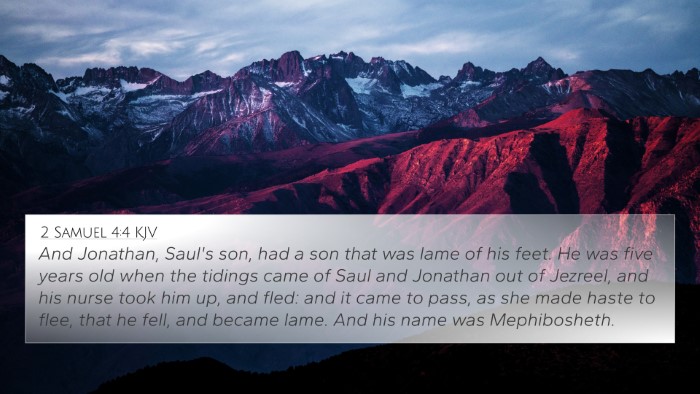Bible Verse Meaning: 1 Chronicles 9:40
Verse Context: 1 Chronicles 9:40 states, "And the sons of Uzziel; Micah; of the sons of Micah, Shamir.” This verse is part of the genealogical record that outlines the lineage of the Levites and the priestly families.
Summary of Interpretations
This verse provides important insights into the roles and identities of the descendants of key figures in Israel's history. The Chronicles are often seen as a reaffirmation of God's covenant with His people through their genealogies and a way of connecting the roles of individuals for the purpose of temple service.
Significance of Genealogy
Matthew Henry points out that genealogies illustrate God’s faithfulness across generations. The listing of Uzziel's sons serves not only to preserve the memory of these families but also to affirm the priestly lineage which formed the backbone of Israel’s worship and community life.
Albert Barnes emphasizes that these records validate the significance of the priestly role. The descendants were set apart for temple service, hence their genealogies were meticulously recorded to ensure proper lineage for those who served God directly.
Adam Clarke notes that such records were crucial in establishing the legitimacy of the priesthood. The placement of specific names like Micah and Shamir may serve to highlight particular contributions or roles in service to God within the temple structure.
Inter-Biblical Connections
Several Bible verses relate to the themes present in 1 Chronicles 9:40, which reinforce the understanding of priestly duties and genealogical significance.
- Exodus 6:20: This verse describes the lineage of Aaron and Moses, giving context to the priestly role.
- Numbers 3:30: Outlines the sons of Uzziel in relation to the Levites, establishing their role among God's people.
- 1 Chronicles 6:4-15: Provides a more detailed genealogy of the Levites, including Uzziel's descendants.
- Hebrews 7:14: Discusses Jesus’s connection to the tribe of Judah, contrasting with the Levitical priesthood.
- Malachi 2:4-7: Addresses the role of priesthood and the covenant with Levi, linking back to the themes of faithfulness and service.
- Matthew 1:12: Continues the genealogy theme into the New Testament, showcasing the importance across generations.
- Luke 1:5: Introduces Zechariah as a priest, illustrating the ongoing significance of priestly lineage.
- Acts 6:7: Highlights the growth of the church, which directly connects to the importance of faithful lineage from priestly families.
Cross-Referencing and Thematic Analysis
Cross-referencing such genealogical details reveals not only the importance of bloodlines but underscores God's desire to maintain a holy priesthood among His people. Through these scriptures, we can analyze:
- The role of priestly families: Exploring how genealogies establish legitimacy in service to God.
- Spiritual legacy: Understanding how past generations impact present and future worship practices.
- The calling of specific individuals: Examining the unique roles played by figures like Micah and Shamir in Israel's religious practices.
- Faithfulness through generations: Recognizing God’s continuous guidance and covenant-observing through family lines.
Tools for Cross-Referencing
For deeper study, utilizing tools for cross-referencing such as a Bible concordance or a cross-reference guide can significantly enrich understanding. These resources help connect verses thematically and contextually, illuminating how various passages interact and inform one another.
Cross-Referencing Bible Study Methods
When examining 1 Chronicles 9:40, engaging in cross-reference Bible study is vital. Here are some effective methods:
- Identifying connections: Look for verses that share themes, such as priestly duties and holy living.
- Thematic studies: Group verses by specific themes for a comprehensive understanding of God's message.
- Comparative studies: Analyze the differences and similarities between Old and New Testament teachings regarding priesthood.
- Reference resources: Use resources that provide context on genealogies and their significance.
Conclusion
In conclusion, 1 Chronicles 9:40 offers a glimpse into the design and will of God concerning His people. It reflects on the importance of maintaining a sense of identity, purpose, and continuity within His covenant community. Through explorations of genealogies, we see how every name holds weight, and every lineage serves God's greater narrative of redemption and holiness.




